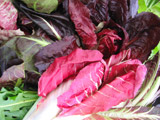Chicory

Chicory, or cichorium intybus, is a bushy perennial herb with blue, lavender, or occasionally white flowers. It grows as a wild plant on roadsides in its native Europe, and in North America and Australia. The chicory root is also often ground and used as a coffee substitute or roasted and added to beer to give it a unique flavor.
Commonly cultivated varieties include Belgian endive, radicchio, and puntarelle. Belgian endive (not to be confused with endive, a close relative of the chicory), is a crisp, pale yellow chicory with bitter leaves that are excellent grilled or stuffed and served as an hors d’oeuvre.
Often referred to as Italian chicory, radicchio is a dark maroon color with leaves that have white veins and a bitter taste that can be reduced through cooking. Different varieties are named according to the Italian region from which they originated. The most well-known variety is the Chioggia, which can grow to the size of the grapefruit. In Italy, radicchio is often eaten grilled or cooked with olive oil and in the United States, the leaves are often eaten raw in salads. Radicchio can also be found mixed in pastas, pizzas, and risottos.
The slender, serrated leaves of the puntarelle have many of the same distinctive tastes and characteristics as its relatives. Its crisp leaves are said to have the spiciness of arugula with hints of fennel, and the shoots have the texture of celery. Puntarelle is traditionally used raw in salads and is classically served with a heavy dressing, often with anchovies, that helps sweeten its bitter notes. Some chefs recommend soaking the leaves in water for a few hours before cooking, allowing the leaves to curl, becoming juicier and less tart.

